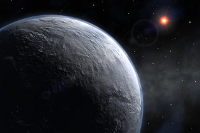

Exoplanets
Researchers in this team are interested in different aspects of exoplanetary physics, using theoretical and observational studies.
Their work focuses on characterizing exoplanets (discovery of new systems, atmospheric evaporation, precise mass determination,
magnetized environments), studying their environments and exocomets. They rely on cutting-edge expertise (transits, radial velocities,
gravitational microlenses) and modeling. These methods are applied to data from numerous observation programs on the major instruments
in the field, both from the ground (SPIRou, Sophie, Harps-N, Pionier) and from space (JWST, HST). The complementary expertise of team
members in obtaining, analyzing and interpreting observations obtained using different techniques (spectroscopy, photometry,
interferometry, etc.) means that interesting synergies can be exploited between ground-based and space-based observations,
including in the context of major international projects currently underway or in preparation: in particular the Esa Plato missions
and especially Ariel, in which IAP has co-PI status.
Among the team's structuring activities is the study of the Doppler shift of absorption lines, which enables us to detect the presence
of planets around other stars. Analysis of the transmission spectrum of stellar flux through the atmosphere of a transiting exoplanet
allows us to measure the chemical composition and other physical parameters of this atmosphere. The spectroscopic data used by
researchers comes from large ground-based telescopes (OHP, ESO, etc.) or space observatories (HST, FUSE, Spitzer in particular).
In addition, the study of the structure of planetary atmospheres, their magnetospheres and the interaction between the magnetosphere
and the stellar wind of the parent star, as well as the dynamics of protoplanetary disks in formation, provide a broader view of
planetary environments. This work is based, among other things, on extensive numerical simulations.
Finally, the team is heavily involved in exoplanet search programs using the gravitational microlensing technique.
- IAP helps organize the Ariel data Challenge 2024 : August 2024
- >more info
- Discovery of an exoplanetary system including a cold sub-neptune : January 2024
- >more info
- Two planetary systems discovered around stars similar to the sun : December 2023
- >more info
UMR7095 - Institut d'Astrophysique de Paris - 98 bis boulevard Arago - 75014 Paris - Tél. 33 (1) 44 32 80 00 - Fax 33 (1) 44 32 80 01 | Contact | Access | Sitemap |
Layout in 2010 | cookies management | Legal notice |


